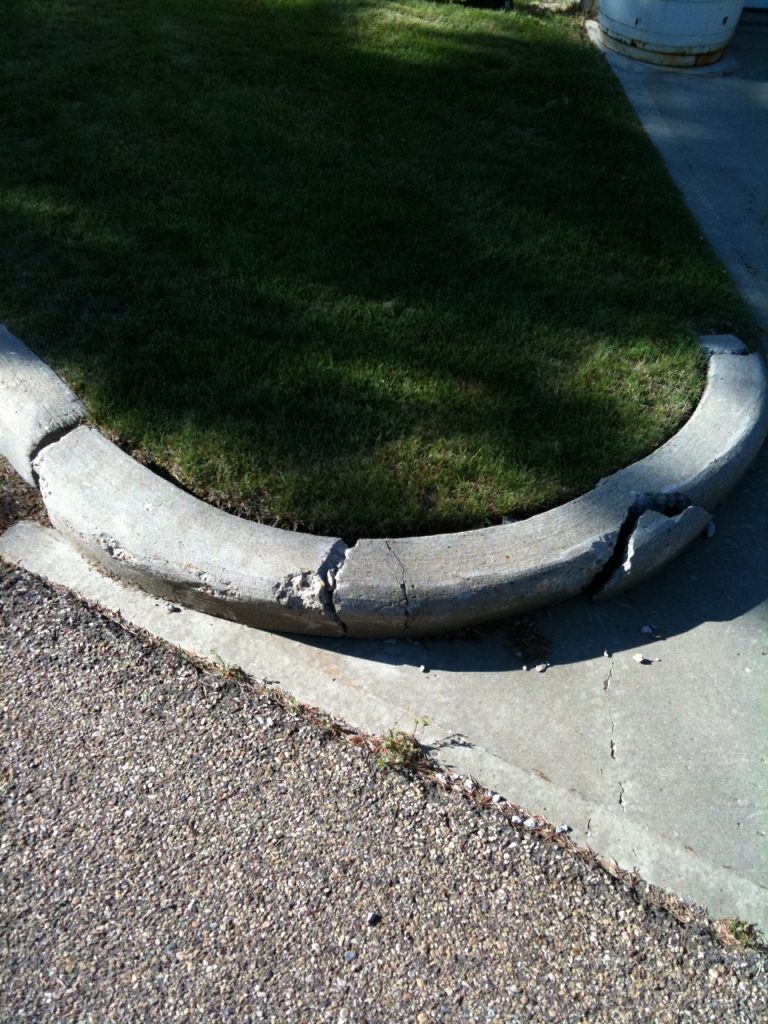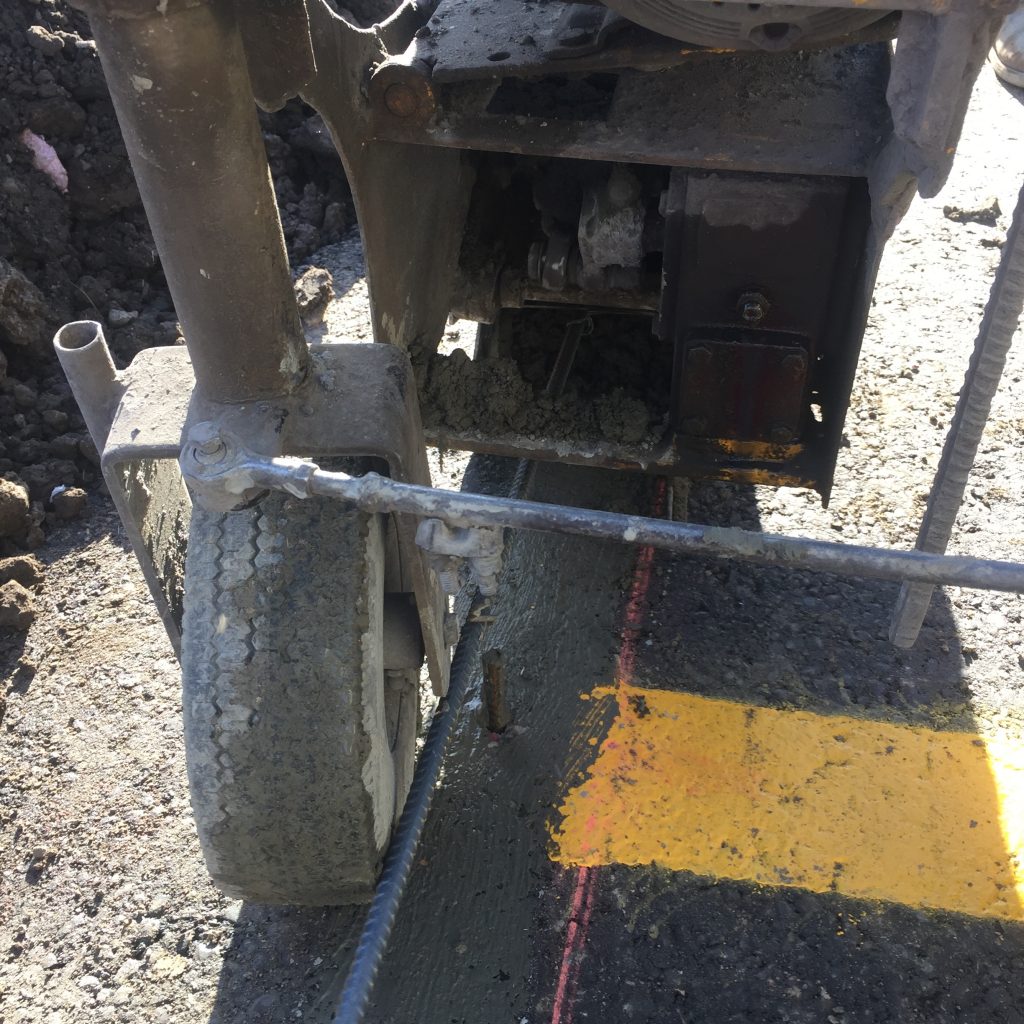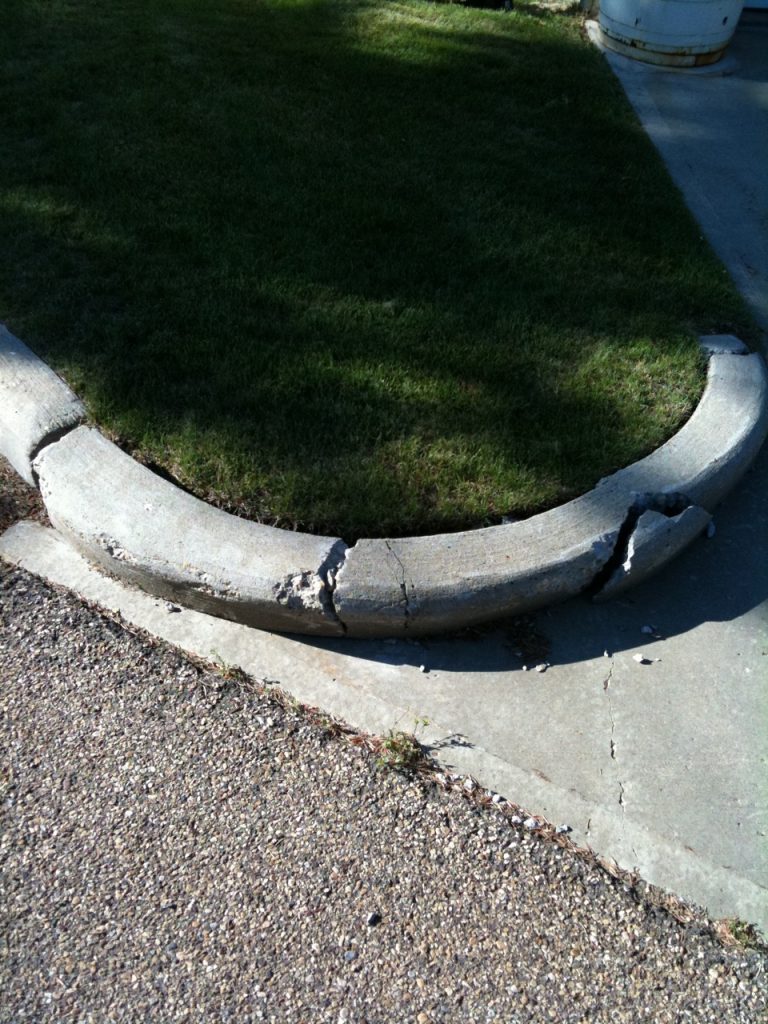Here is a topic for some debate- and I think its high time we had this discussion.

In Edmonton, we typically see pin on curbs installed with vertical pins and horizontal rebar. So that is how we have been installing curbs, because the engineers and architects call for it on the drawings.
BUT…With our severe winters accompanied by snow removal activity we also see a lot of broken curbs (not just ours!) come spring. No matter how tough the pins, or the concrete, often the curb is fractured at the vertical pin locations, and ends up in a tangled mess after being lifted by the skid steer or loader. It often has bits of the horizontal rebar sticking out causing dangers for pedestrians and possible liability issues. We feel that properly bonding of curbs to asphalt is better than use of steel alone. It may also be that NO STEEL is better as long as the curb is well bonded to the base. It is time we did some testing in our climate to see if maybe we aren’t better off using no steel at all! According to Jon Julnes of Tilco Vanguard, in Washington state, this would make for lower costs, less impact damage and easier repairs in the future should there be damage.
Read the article, and let me know in the comments section what you think! Be sure to summarize your experience/ credentials in your comment!
In any case, the photo illustrates our usual system.

The following article is by Jon Julnes CEO: TILCO Vanguard Inc / Vanguard ADA Systems / DisposaCone: Tilco Vanguard Inc. Snohomish WA, USA phone 1-425-483-5700
This should be read by anyone considering installation of pin on curbs.
Here is the text used by permission:
[start Tilco article:]
Extruded Curbs
Why do we propose 5 inch tall curbs over 6 inch tall curbs?
A reasonable guess would be “they use less material” and that is certainly true. A shorter curb however, using the simplest laws of physics, is simply a much stronger curb.
Huh?!
It’s fairly simple; when you impact the curb in a downward fashion, “shear” is nearly impossible. When you impact the curb from the side, “shear” is certain.
We also have 6 inch tall curbs for sale and we’ll gladly install them for you but, a 5 inch tall curb will always be stronger, always last longer, andalways cost less, both long term and short.
Steel in extruded curbs
Well…….
Extruded curbs get their strength from how well they’re bonded to the surface. Nothing else. Bonded properly, they should rip up the substrate they’re attached to if indeed they ever fail. Bonded poorly, steel will only add to the cost, temporarily increase their integrity, addzero to the long term integrity and only raise (exponentially) the cost to remove, replace and repair later.
With extruded curbs, if you put steel in horizontally (lengthwise), the only thing steel will provide is; every impact will transfer the energy and shock directly to the steel through its entire length (the steels length, that is). Kinetic/transferred energy 101. (Blame Copernicus…he’s the one that invented calculus and made all this stuff simple).
curbingIn the beginning (the first impact), the energy transfer goes first to the steel. As the bond becomes weaker due to ongoing impacts, more of the energy transfers to the bond itself, carrying out now (thanks to the continuous piece of steel) not just small sections, but ever increasingly larger ones (remember…you paid extra for this).
How about pins placed vertically (up and down/top to bottom)? In most DOT designs, steel pins are placed every 10 – 20 feet on center.
For the sake of argument, we’ll assume on this test that we’ve used the world’s strongest bonding agent…”Curb Super Glue”.
What happens when impact occurs? It goes, understandably, where the laws of physics dictate stored energy gets diffused; Once again….the steel….first. Upon impact (any) a specific amount of energy is transferred through the entire section of extruded curb. But, guess where 90% of the energy actually goes? Like a lightning rod…. directly to the nearest steel pin.
It’s science. And it’s immutable. Energy will transfer to its most logical “exit” point. (For clarity, the laws of physics do not require your agreement).
In very short order, that curb will break…first, at one of the pins, eventually creating a small concave chunk at same. Energy waves expand, never contract (unless of course you happen to be directly in the gravity field of a black hole, where of course, they do and, well, you probably won’t be reading this anyway), therefore, once it finds its outlet (remember: lightning rod), the energy wave reverberates directly away from the steel pin, outward.
We know this to be true because we all learned in 7th grade that Newton’s third law (“Every action {energy/impact} has an equal and oppositereaction“) causes the action (impact) to cause an equal and opposite reaction (the reverberation outwards from said pin, ergo, shock “wave”). In short, steel pins in extruded curbs will ensure damage, not protect them from it.
Still don’t believe me? What about all that space in between the pins? If steel pins in extruded curbs are such a great idea, shouldn’t there be steel in all of those blank spaces as well? What happens where there are no steel pins at all?
Ironically, the sections without steel will actually break last, not first.
Steel in extruded curbs is just simply a remarkably bad idea. It’s a complete waste of money. It costs you additional money for less (not even equivalent) value. Any extruded curb without steel, is superior to ANY extruded curb with steel. (Really). Of course, if it’s bonded poorly (with no steel) it will be vastly cheaper to repair, by several orders of magnitude. If, however it is bonded properly, it won’t need repairs!
(And if we installed it….it won’t need repairs).
With all that said, if you must, we have all the requisite equipment, tools and skill sets necessary to install steel in your curbs either horizontally or vertically if you truly want it there. Be certain however, with steel, your ROI will be greatly diminished, from Day One.
Hey…..what about cracks in curbing?
Good question. Concrete expands and contracts (actually….everything does…even you). It’s normal. Most of the cracks that occur in concrete, should take place in what are called “expansion joints”….called that because, they’re actually stress point relievers designed specifically to allow concrete to do what it does…expand and contract (next time you go across the bridge…or downtown on I-5, when you feel a slight bump…that’s an expansion joint, designed in so the concrete doesn’t expand and buckle, rather, expands…and then contracts again, minimizing cracking. Those expansion joints, amazingly, are two inches wide! And there’s 100’s of them!). Small cracks in extruded curbs are fine, as they are in (most) concrete slabs. They’re simply an indication that it got hot enough one day that the designed in expansion joints didn’t cover the entire “load”. So long as they’re bonded well….you’re perfectly fine.
Speaking of which…
Bonding/Adhesion
I’m about to break the long standing magicians code. Here’s the recipe for the best bonding agent for extruded curbs (placed on asphalt) on Earth: 1 empty 5 gallon bucket. Add 2+ gallons of water. Mixing bit and drill. Turn on mixing drill. Slowly and evenly pour Portland cement in to said bucket while mixing with drill until material is (evenly and throughout) the consistency of a somewhat thin pudding (there’s a few other items to put in, latex modifiers, calcium chloride and such, but that’s basically it). Take synthetic (plastic) bristle house broom, dip into bucket, “paint” on surface where curb goes, enough such that when curb is placed over top of same, a nearly indiscernible amount oozes out of each side…finish curb with appropriate trowel…rinse, repeat.
Over the last 38+ years, we have turned down multiple projects where the designer(s) insisted on using some high tech 3 part polymer epoxy (which never works as well as the above), only to be called in 3 years later (by the owner, who already paid to have it done right the first time) to be paid 4 times our original proposal for the entire project, to repair just 15 – 20% of same. The rest of course, will come out over the next 5 – 10 years.
There is only one exception to the above; when extruded curbs are installed over concrete. Only at that time is an epoxy a better design standard. (Email us for the appropriate spec and we will happily assist).
So, in summation; shorter is better than taller, it uses less material so it’s better for the environment meaning fewer trips to pick up, less C02 etc. and, it will last longer via basic physics. No steel is always better than any steel and…. the best bonding agent isn’t some high tech chemical concoction that some genius in a lab came up with, it’s what we developed in house 38+ years ago, and it’s still today, the best product out there (and the only one we’ll warranty).
************************************************
The difference between good and great is almost always; Experience.
TILCO Vanguard has more than 38 years of it (more than anyone else in the entire Puget Sound).
Jon Julnes
CEO: TILCO Vanguard Inc / Vanguard ADA Systems / DisposaCone
www.tilco.net
www.VanguardOnline.com
www.DisposaCone.com
(TILCO) 425 483 5700
(Vanguard ADA Systems) 360 668 5700
“Discipline is the bridge between goals and accomplishment”
18122 SR 9 SE, Suite F
Snohomish WA 98296
It really does matter who you hire. [end Tilco article] Here is the link to the original Tilco curbs article on steel and bonding . Tilco has 35 plus years experience in the Washington State Puget Sound area

Comments are closed.